Clay art therapy can profoundly ease your anxiety at home through its tactile and sensory experiences. As you mold and shape the clay, you activate calming signals in your brain, lowering your heart rate and blood pressure. The process encourages mindfulness, grounding you in the present moment and distracting you from anxious thoughts. You'll express emotions nonverbally, transforming abstract feelings into tangible forms. The repetitive motions and focus required can induce a meditative state, reducing stress and promoting relaxation. Clay's versatility allows for endless creative possibilities, boosting your self-esteem as you complete projects. Discover how this accessible art form can become a powerful tool in your anxiety management toolkit.
Tactile Sensations and Anxiety Relief

Through the process of molding and shaping clay, you're engaging in a deeply tactile experience that can greatly reduce anxiety. As you work the clay with your hands, you're activating various sensory receptors that send calming signals to your brain. This physical interaction helps shift your focus away from anxious thoughts and onto the present moment.
The cool, smooth texture of clay provides a soothing sensation that can lower your heart rate and blood pressure. As you knead, roll, and manipulate the material, you're releasing tension in your muscles and promoting relaxation throughout your body.
The repetitive motions involved in clay work can induce a meditative state, further reducing stress and anxiety. Clay's malleable nature allows you to express emotions that might be difficult to verbalize. By physically shaping your feelings, you're giving them form and making them more manageable.
This process can help you gain a sense of control over your anxiety. Additionally, the act of creating something tangible provides a sense of accomplishment, boosting your self-esteem and counteracting negative thought patterns often associated with anxiety.
Mindfulness Through Clay Manipulation
When you focus on the tactile sensations of clay, you'll find your mind naturally calming.
As you shape the clay with your hands, you're also reshaping your thoughts and worries.
This mindful process of manipulating clay can help you stay present and reduce anxiety-inducing rumination.
Tactile Focus Calms Mind
By focusing on the tactile sensations of clay, you can quiet your racing thoughts and enter a state of mindfulness. As you manipulate the clay with your hands, you'll notice its cool, smooth texture and how it warms up with your body heat.
Pay attention to the way it yields to pressure, how it stretches and compresses under your fingers. This tactile focus helps redirect your mind from anxious thoughts to the present moment.
You'll find yourself absorbed in the sensory experience, noticing the clay's resistance as you knead it, the subtle changes in its consistency as you work, and the satisfying feeling of shaping it into various forms.
The repetitive motions of rolling, pinching, and smoothing the clay can have a meditative effect, further calming your mind.
As you immerse yourself in these sensations, you'll likely experience a decrease in muscle tension and a slowing of your breath. This physical relaxation reinforces the mental calm, creating a positive feedback loop that can greatly reduce anxiety symptoms.
Shaping Clay, Reshaping Thoughts
Clay manipulation serves as a powerful metaphor for reshaping your thoughts and emotions. As you mold and shape the clay, you're actively engaging in a process of transformation that mirrors your mental state. This hands-on approach to mindfulness allows you to externalize your inner experiences, giving tangible form to abstract thoughts and feelings.
When you work with clay, you'll notice:
- Your focus shifts from anxious thoughts to the present moment
- You gain a sense of control over your environment
- Your creativity emerges, opening new pathways for self-expression
As you knead, press, and form the clay, you're not just creating art; you're retraining your brain to approach challenges differently. The malleability of clay reminds you that your thoughts and emotions are equally flexible. You can reshape negative thought patterns into more positive, constructive ones.
This process encourages a growth mindset, helping you see obstacles as opportunities for change. By physically manipulating clay, you're practicing the mental skill of adapting to new situations and perspectives.
Over time, this practice can lead to increased resilience and a more balanced emotional state, reducing anxiety's grip on your daily life.
Expressing Emotions Without Words

You'll find that clay art therapy offers a powerful way to express emotions without relying on words.
As you manipulate the clay, you're engaging in a tactile exploration that can help release pent-up feelings and reduce anxiety.
Through this process, you can create symbolic representations of your emotions, allowing for a deeper understanding and processing of your inner experiences.
Nonverbal Emotional Release
Many individuals find it challenging to verbalize their emotions, especially when dealing with anxiety. Clay art therapy offers a unique opportunity for nonverbal emotional release, allowing you to express your feelings without the pressure of finding the right words. As you mold and shape the clay, you're channeling your emotions into a tangible form, creating a physical representation of your inner experiences.
This process of nonverbal expression can be particularly beneficial for:
- Those who struggle with articulating complex emotions
- Individuals who feel overwhelmed by traditional talk therapy
- People who prefer hands-on, creative approaches to managing anxiety
When you engage in clay art therapy, you're tapping into a primal form of communication. Your hands become the conduit for your emotions, translating abstract feelings into concrete shapes and textures.
This tactile experience can help you bypass mental blocks and access deeper layers of your psyche. As you work with the clay, you may find yourself releasing pent-up emotions, reducing stress, and gaining new insights into your anxiety.
The act of creation itself can be cathartic, providing a sense of accomplishment and control over your emotional state.
Tactile Sensory Exploration
Through tactile sensory exploration, clay art therapy offers a unique way to express emotions without uttering a single word. As you knead, mold, and shape the clay, you're engaging in a physical dialogue with your feelings. The malleable nature of clay allows you to literally manipulate your emotions, giving form to abstract thoughts and sensations.
You'll find that the texture and temperature of the clay provide immediate sensory feedback, grounding you in the present moment. This tactile experience can be particularly soothing for those struggling with anxiety, as it redirects focus from racing thoughts to the physical sensations at hand. As you work the clay, you're not just creating art; you're also developing a deeper connection with your body and emotions.
The act of squeezing, smoothing, and sculpting clay can serve as a metaphor for processing and transforming difficult emotions. You might find yourself instinctively creating shapes or forms that represent your inner state, allowing for a nonverbal expression of complex feelings.
This tactile exploration often leads to unexpected insights and emotional release, making clay art therapy a powerful tool for managing anxiety at home.
Symbolic Representation Creation
Building on the tactile exploration of clay, symbolic representation creation takes the therapeutic process a step further. This technique allows you to express complex emotions and thoughts without relying on words. As you mold the clay, you're creating tangible representations of your inner world, making abstract feelings concrete and manageable.
When you're working with clay to create symbolic representations, you're engaging in a powerful form of non-verbal communication. You might shape a small, tightly wound ball to represent anxiety, or craft a tall, sturdy pillar to symbolize strength. The process of transforming your emotions into physical forms can be incredibly cathartic and insightful.
Here are three ways symbolic representation in clay therapy can help ease your anxiety:
- Externalizing your feelings, making them easier to confront
- Providing a safe, non-verbal outlet for complex emotions
- Offering a tangible way to track your emotional progress over time
Grounding Techniques in Clay Work
In addition to its creative aspects, clay work offers powerful grounding techniques for those struggling with anxiety. When you're feeling overwhelmed, focusing on the physical sensations of clay can bring you back to the present moment.
Start by holding a piece of clay in your hands and paying attention to its texture, temperature, and weight. Squeeze it gently, noticing how it responds to pressure.
As you work with the clay, concentrate on your breathing. Inhale deeply as you press the clay, and exhale slowly as you release it. This rhythmic process can help calm your nervous system.
Try creating simple shapes or patterns, like rolling the clay into a ball or flattening it into a disc. These repetitive motions can be soothing and meditative.
You can also use the clay to express and release tension. Knead it vigorously, punch it, or tear it apart. As you do this, imagine your anxiety leaving your body and transferring into the clay.
Afterward, reshape the clay, symbolizing your ability to transform negative emotions into something new and positive.
Creating Order From Chaos
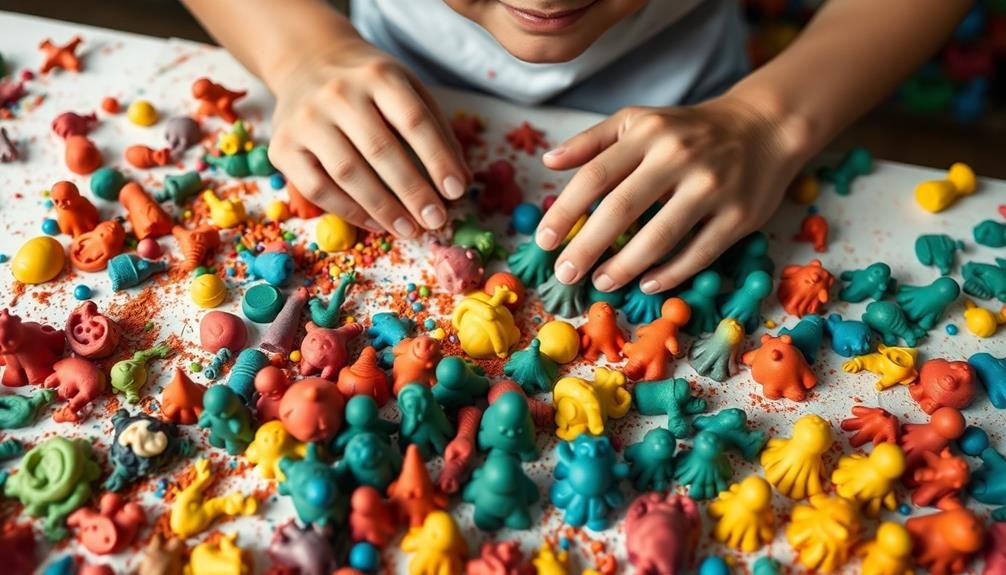
Clay art therapy offers a unique opportunity to create order from chaos, mirroring the process of managing anxiety. As you mold and shape the clay, you're also reshaping your thoughts and emotions. This tactile experience allows you to physically transform a formless lump into a structured creation, symbolizing your ability to bring clarity to your anxious mind.
When you're feeling overwhelmed, try this clay exercise:
- Start with a large, unformed mass of clay.
- Gradually divide it into smaller, manageable pieces.
- Arrange these pieces into a harmonious composition.
This process helps you break down your anxiety into more manageable parts. You'll find that as you organize the clay, you're also organizing your thoughts. The act of creating something tangible from an amorphous blob can be incredibly empowering, reminding you that you have the ability to bring order to your life.
As you work, focus on the sensations in your hands and the changes you're making to the clay. This mindful approach helps ground you in the present moment, reducing anxiety about the future or past.
You're literally and figuratively molding chaos into order, one piece at a time.
Stress Reduction Through Repetitive Motions
You'll find that the repetitive motions involved in clay work can considerably reduce stress.
As you knead, roll, or shape the clay, these rhythmic movements help calm your nerves and settle your mind.
The mindful repetition of these actions allows you to focus on the present moment, soothing your thoughts and easing anxiety.
Rhythmic Movements Calm Nerves
Repetitive motions in clay art therapy offer a powerful avenue for stress reduction and anxiety relief. As you engage in rhythmic movements while working with clay, your nervous system begins to calm down. The consistent, predictable actions create a soothing effect on your mind and body, helping to alleviate anxiety symptoms.
When you're feeling overwhelmed, try these clay-based activities to calm your nerves:
- Kneading and rolling clay
- Creating small, repetitive patterns or textures
- Smoothing the surface of a clay piece
These rhythmic movements activate your parasympathetic nervous system, which is responsible for the "rest and digest" response. As you focus on the repetitive motions, your breathing naturally slows down, and your heart rate stabilizes. This physiological shift helps counteract the effects of stress and anxiety.
Moreover, the tactile nature of clay work engages your senses, grounding you in the present moment. As you immerse yourself in the rhythmic movements, you'll find your mind becoming less preoccupied with worries and more focused on the calming task at hand.
Mindful Repetition Soothes Mind
Mindful repetition in clay art therapy offers a powerful avenue for stress reduction. As you engage in repetitive motions like kneading, rolling, or coiling clay, you'll find your mind begins to quiet. This repetition allows you to focus on the present moment, letting go of anxious thoughts about the past or future.
You'll notice that as you repeat these actions, your breathing naturally slows and becomes more rhythmic. This physiological response helps calm your nervous system, reducing feelings of anxiety. The consistent, predictable nature of these movements provides a sense of control and stability, which can be particularly soothing when you're feeling overwhelmed.
Moreover, the tactile sensation of working with clay grounds you in the present. You'll become acutely aware of the clay's texture, temperature, and malleability. This sensory focus acts as a form of mindfulness meditation, redirecting your attention away from stressors.
Self-Expression and Emotional Release
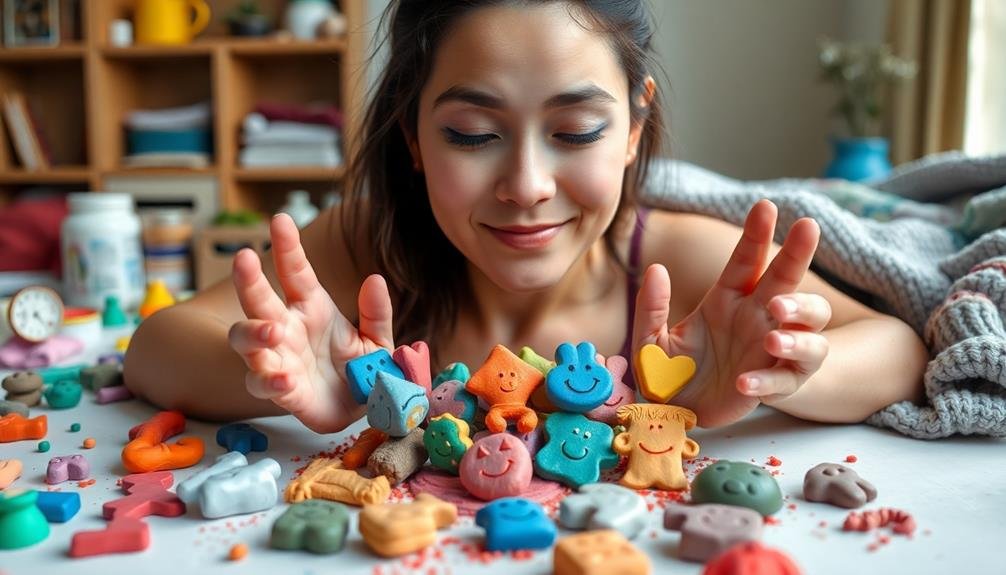
Freedom of expression lies at the heart of clay art therapy for anxiety. When you work with clay, you're free to create without judgment or expectations. This unrestricted approach allows you to tap into your innermost thoughts and feelings, giving them tangible form.
As you mold and shape the clay, you're simultaneously shaping your emotions, providing a safe outlet for pent-up anxiety and stress. Clay's malleable nature mirrors the fluidity of your emotions, allowing you to:
- Externalize complex feelings that are difficult to verbalize
- Confront and process challenging emotions in a non-threatening way
- Discover new insights about yourself through your creations
You'll find that the act of manipulating clay can be cathartic, offering a physical release for emotional tension. As you knead, roll, and sculpt, you're not just creating art; you're engaging in a form of non-verbal communication with yourself.
This process can help you identify and understand the root causes of your anxiety, leading to greater self-awareness and emotional regulation. By giving form to your fears and worries, you're taking the first step towards managing them effectively.
Boosting Self-Esteem Through Creation
Clay art therapy's power to boost self-esteem is undeniable. As you mold and shape the clay, you're not just creating art; you're building confidence in your abilities. Each piece you complete serves as a tangible reminder of your creative potential and personal growth. The process of transforming a shapeless lump into a meaningful object mirrors your own capacity for change and improvement.
You'll find that working with clay allows you to set achievable goals and experience a sense of accomplishment. Whether you're crafting a simple pinch pot or a complex sculpture, the act of finishing a project reinforces your belief in your capabilities. This newfound confidence often extends beyond the art studio, positively impacting other areas of your life.
Clay art therapy also encourages self-acceptance. As you learn to embrace imperfections in your creations, you'll develop a more compassionate attitude towards yourself. The tactile nature of clay work grounds you in the present moment, helping you focus on your strengths rather than dwelling on perceived shortcomings.
Through regular practice, you'll cultivate a stronger sense of self-worth and resilience against anxiety-inducing thoughts.
Distraction From Anxious Thoughts

When anxiety grips your mind, clay art therapy offers a powerful escape. As you immerse yourself in the tactile experience of molding clay, your focus shifts away from anxious thoughts. The act of creation demands your full attention, leaving little room for worry to creep in. You'll find your hands busy and your mind occupied with the task at hand, effectively redirecting your mental energy.
Clay art therapy provides a multisensory distraction that engages various parts of your brain:
- Visual stimulation: Observing the clay's transformation
- Tactile sensation: Feeling the texture and temperature changes
- Kinesthetic involvement: Using your muscles and coordination
As you work with the clay, you're not just distracting yourself; you're actively engaging in a process that promotes mindfulness. The repetitive motions of kneading, shaping, and smoothing can be meditative, helping to calm your nervous system.
You'll often find that time seems to slip away as you become absorbed in your art, providing a much-needed break from the constant chatter of anxious thoughts.
Clay's Versatility in Art Therapy
One of the most compelling aspects of clay art therapy is its remarkable versatility. You can mold clay into virtually any shape, allowing for endless creative possibilities. This flexibility means you're not limited to a single form of expression, unlike other art mediums that may have more constraints.
When working with clay, you can create sculptures, functional objects, or abstract forms. You'll find that clay adapts to your mood and needs, whether you're feeling energetic and want to build something complex, or you're seeking calm and prefer simple, repetitive motions.
The tactile nature of clay also offers various sensory experiences. You can choose smooth, fine clay for delicate work or rougher textures for a more grounding experience.
Clay's versatility extends to the techniques you can use. You might opt for hand-building methods like pinching, coiling, or slab construction. Alternatively, you could explore wheel throwing if you're interested in creating symmetrical forms.
This variety guarantees that clay art therapy can cater to different skill levels and preferences, making it an accessible and adaptable tool for managing anxiety.
Social Connection via Clay Workshops

While individual clay therapy sessions offer numerous benefits, participating in clay workshops can amplify the anxiety-reducing effects through social connection.
You'll find yourself in a supportive environment where you can share experiences and techniques with others who may be facing similar challenges. These group settings foster a sense of community and belonging, which can be incredibly powerful in managing anxiety.
Clay workshops provide unique opportunities for social interaction:
- Collaborative projects: Work together on larger sculptures or installations, building trust and teamwork skills.
- Skill-sharing sessions: Learn from others and teach your own techniques, boosting confidence and self-esteem.
- Group discussions: Reflect on the creative process and share personal insights, deepening your understanding of anxiety management.
You'll likely find that the shared experience of working with clay helps break down social barriers and encourages open communication.
As you engage in tactile activities alongside others, you may notice a natural reduction in anxiety symptoms. The combination of creative expression and social connection can lead to lasting friendships and a broader support network, enhancing your overall mental well-being long after the workshop ends.
Frequently Asked Questions
Is Clay Art Therapy Suitable for Children With Anxiety Disorders?
Yes, clay art therapy is suitable for children with anxiety disorders. You'll find it's an engaging, tactile activity that can help your child express emotions, reduce stress, and improve focus. It's a safe, creative outlet for managing anxiety.
How Long Should a Typical Clay Art Therapy Session Last?
You'll typically spend 45-60 minutes in a clay art therapy session. However, it's flexible based on your needs and progress. Don't rush; take the time you need to explore, create, and process your emotions through clay work.
Can Clay Art Therapy Be Combined With Other Forms of Therapy?
Yes, you can combine clay art therapy with other therapeutic approaches. It's often integrated with cognitive-behavioral therapy, mindfulness practices, or talk therapy. You'll find that this combination can enhance your overall treatment and provide a more holistic healing experience.
Are There Any Potential Allergic Reactions to Clay Materials?
You should be aware that some people may experience allergic reactions to clay materials. It's possible you could have skin irritation or respiratory issues. If you're concerned, consult your doctor before starting clay art therapy.
What Qualifications Should a Clay Art Therapist Have?
You'll want a clay art therapist with a master's degree in art therapy, licensed by your state. They should have specific training in clay techniques and experience working with your particular concerns. Look for professional certifications too.
In Summary
You've discovered a powerful tool for managing anxiety right at home. Clay art therapy offers you a unique blend of tactile engagement, emotional expression, and mindful creativity. As you mold and shape the clay, you're also reshaping your mental state. Whether you're working alone or joining virtual workshops, this versatile medium can ground you, boost your confidence, and provide a welcome distraction from anxious thoughts. Give clay art therapy a try—your mind will thank you.
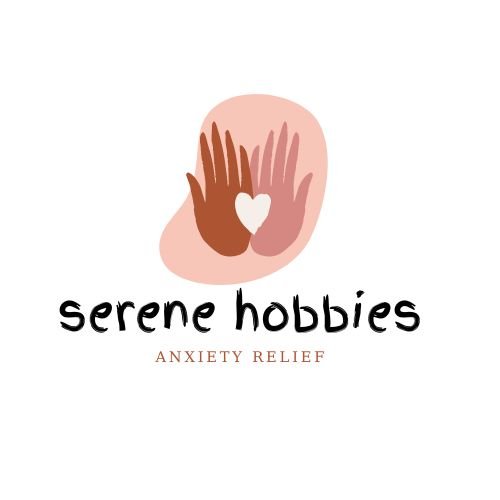


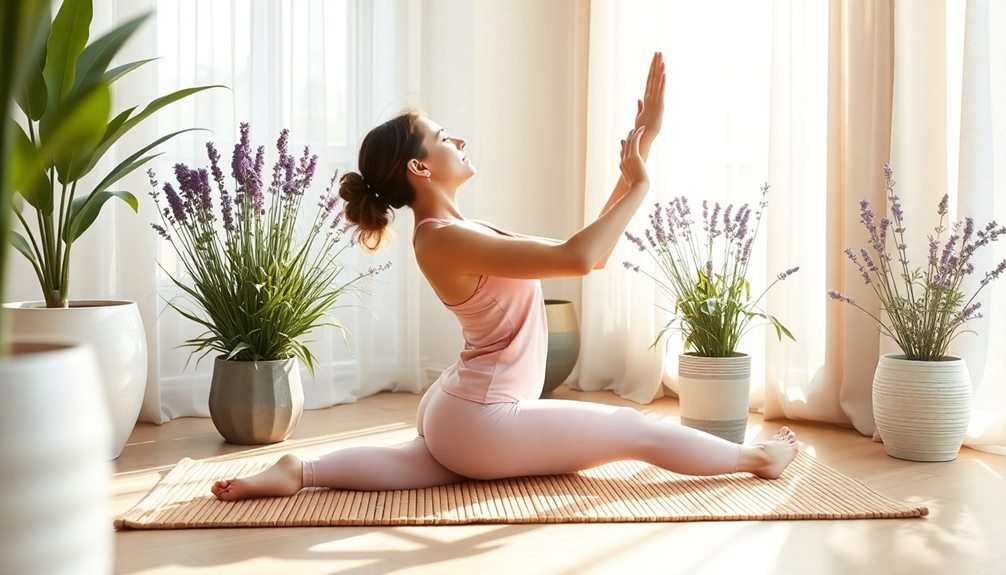
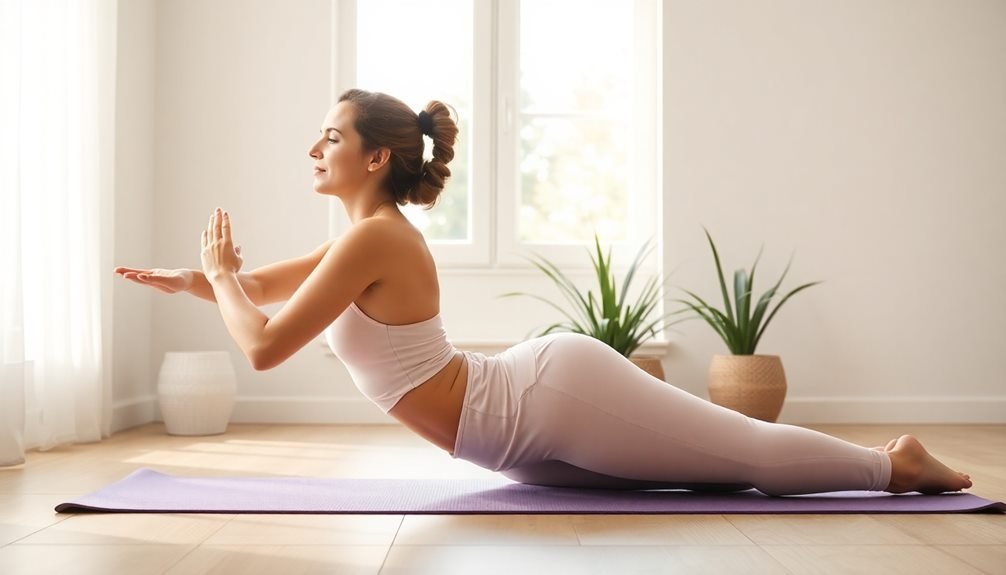
Leave a Reply